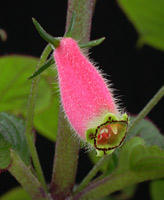Seemannia
Full name and orig. publication:
Seemannia Regel, Gartenflora 4: 183 (1855).
Etymology: Named after Berthold Carl Seemann
(1825-1871), a German-born botanist, plant collector and explorer.
Synonyms: Fritschiantha Kuntze
(1898), Fiebrigia Fritsch (1913).
Infrafamilial position: Gesnerioid Gesneriaceae (Gesnerioideae)
- Gloxinieae.
Description: Terrestrial perennial herbs with scaly
rhizomes, often produced at the tips of long stringy rhizomes. Stem erect or
decumbet. Leaves opposite, ternalte or whorled, ± isophyllous, petiolate,
lamina with 3-9 pairs of veins. Flowers axillary, usually solitary (except S.
sylvatica), epedunculate and ebracteolate, showy. Sepals free. Corolla
tubular or inflated, often constricted at the mouth, red, orange, purple, rarely
yellow; with barrel-shaped multicellular trichomes at the tube entrance; limb of subequal,
entire lobes. Stamens 4; anthers coherent. Nectary annular. Ovary half- to
completely inferior. Fruit a dry rostrate capsule. Seeds numerous, minute, ellipsoid.
Chromosome number: 2n = 26.
Species number:
4.
Species names (incl. publication and synonyms): See Skog, L.E. &
J.K. Boggan. 2005: World checklist of Gesneriaceae: http://persoon.si.edu/Gesneriaceae/Checklist.
Type species: Seemannia
ternifolia Regel, type = S. sylvatica (Kunth) Hanst.
Distribution:
Mainly in the Andes of South America: Bolivia, northern Argentina and southern
Peru. S sylvatica extends to southern Ecuador.
Ecology: Terrestrial herbs, growing on earth
banks or rocks in forest; seasonally dormant.
Notes:
Seemannia was recognized as a valid genus by Fritsch (in "Die Natürlichen
Pflanzenfamilien" 1893-94) and other botanists. However, Wiehler
(1975), based on hybridization experiments, included it in the considerably
enlarged genus Gloxinia. Recent molecular work
showed that the four
species S. sylvatica, S. purpurascens, S. gymnostoma, and S.
nematanthodes, form a distinct group and can be technically easily
separated from the closely genus related Gloxinia (Roalson et al.
2005a,b; Boggan 2006). S. purpurascens and S. sylvatica have
scarlet flowers (combined with a bright yellow tube interior in the latter
species), suggesting pollination by birds.
Selected references: Wiehler, Selbyana 1: 380-388 (1976),
incl. in Gloxinia; Roalson, Boggan, Skog, Zimmer,
Taxon 54(2):
389-410 (2005a), molec. syst.; Roalson, Boggan, Skog, Selbyana 25(2):
225-238 (2005b), tax.; Boggan, Gesneriads 56 (3): 26-32 (2006), surv.
Bibliography: See Skog, L.E. & J.K. Boggan.
2005. Bibliography of the Gesneriaceae. 2nd edition: http://persoon.si.edu/Gesneriaceae/Bibliography.
Illustrations:
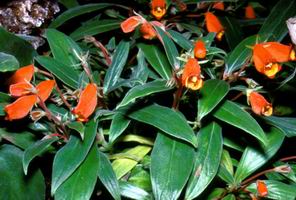
|
Seemannia sylvatica (Kunth) Hanst.
[formerly Gloxinia
sylvatica (Kunth) Wiehler]
Cult. BG
Vienna, phot. A. Weber (1980)
Vienna
|
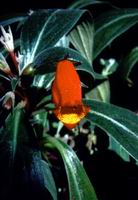
|
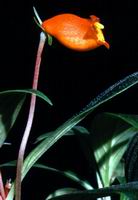
|
Seemannia
sylvatica (Kunth)
Hanst.
[formerly Gloxinia
sylvatica (Kunth) Wiehler]
Cult. BG
Vienna, phot. A. Weber (1980)
|
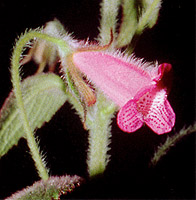
|
Seemannia gymnostoma (Griseb.) Toursark.
[formerly Gloxinia gymnostoma
(Griseb.) Wiehler]
Gloxinian 56 (3): 30 (2006), phot. A. Chautems
|
last modified: 2007-01-08




